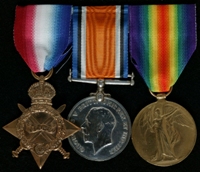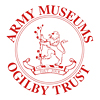

(L to R) 1914-15 Star; British War Medal; Allied Victory Medal
Harold was born in July 1894 in Bradford, Manchester. His father's name was James and his mother was Emily Annie. He had two brothers: Frank was older and James was younger. The family lived at 4 Parcel Street in Beswick, Manchester and James was a stoker for a stationary engine. In 1911 we know he held this job at a Municipal Council cleaning Depot, although we don't know which one. It is possible that he worked here in 1901 as well.
By 1911 Harold was working for Simpson and Godlee, a cotton spinning and manufacturing company based at 8 Minshull Street in Manchester. He was a Warehouseman, although we don't know his exact role within the company.
When the First World War broke out in August 1914 Harold was one of thousands of Manchester men who enlisted into Manchester's 1st City Battalion so that they could serve in the Army together. Harold enlisted on the 4th September 1914 and was given the service number 6953. This unit became the 16th Battalion of the Manchester Regiment and Harold was assigned to XIV Platoon in D Company.
When he enlisted Harold was 5 feet 7 inches tall and weighed 127 pounds. His physical development was assessed as 'Good'.
Harold and the 16th Battalion trained in the UK at Heaton Park, Manchester until April 1915, then at Belton Park near Grantham, Lincolnshire until September when it moved to Larkhill in Wiltshire. On the 9th November the Battalion was sent to France.
On the 9th January 1916 Harold was admitted to hospital suffering from synovitis in his right knee. This does not seem to have kept him away from the front for long because 5 days later he was shot in the left knee and the right leg. These were much more serious injuries and Harold was passed up the medical chain for treatment. We don't know where Harold was sent, but by March 1916 he had recovered and was at the 30th Infantry Base Depot at Etaples in France, waiting for a chance to rejoin his Battalion.
Harold rejoined the 16th Battalion on the 12th April and stayed with it through the Battle of the Somme between July and November, and the fighting around Arras in April and May 1917. He specialised as a bomber, who used hand grenades to clear enemy soldiers from trenches and dug-outs.
On the 31st July 1917 Harold was shot in the back, 1 1/2 inches below his left shoulder blade. This was a serious injury and after an operation in France he was evacuated back to the UK. He spent 66 days in Huddersfield War Hospital before being released. We don't know the details of Harold's movements during this time, but by March 1918 he had been assigned to the 3rd Battalion of the Manchester Regiment, based at Cleethorpes on the Humber Estuary.
Harold was compulsorily transferred to the Army Ordnance Corps as a Clerk on the 29th April. We don't know why this happened. He was given the new service number 041549 and sent to Woolwich in London.
The War ended on the 11th November 1918 and the Army began assessing wounded men to see how much of a pension they were entitled to as civilians. Harold was discharged on the 12th April 1919 and over the next 6 months he was seen and assessed by doctors.
Harold still suffered from the effects of his gunshot wound. He found it painful to lift his left arm above his head, and complained of numbness across his shoulders and down his left arm after exertion which 'takes the use out of arm'. The synovitis in Harold's right knee was also causing him trouble; it would become painful after walking around half a mile.
Harold was awarded a pension of 8 shillings and sixpence (8/6) per week for 26 weeks when he was discharged. After more treatment and assessment this was reduced to 8/- for one year in October. At his assessment in October 1920 Harold was granted 5/6 per week for another year. We don't know whether he continued to receive a pension after this time.
The rest of Harold's life remains a mystery.




